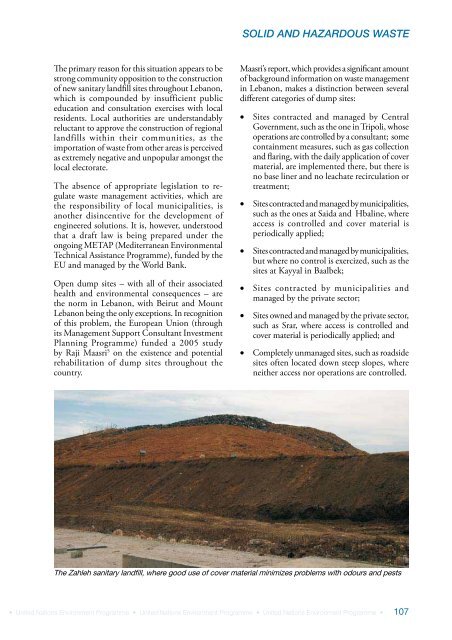Lebanon Post-Conflict Environmental Assessment - UNEP
Lebanon Post-Conflict Environmental Assessment - UNEP
Lebanon Post-Conflict Environmental Assessment - UNEP
Create successful ePaper yourself
Turn your PDF publications into a flip-book with our unique Google optimized e-Paper software.
SOLID AND HAZARDOUS WASTEThe primary reason for this situation appears to bestrong community opposition to the constructionof new sanitary landfill sites throughout <strong>Lebanon</strong>,which is compounded by insufficient publiceducation and consultation exercises with localresidents. Local authorities are understandablyreluctant to approve the construction of regionallandfills within their communities, as theimportation of waste from other areas is perceivedas extremely negative and unpopular amongst thelocal electorate.The absence of appropriate legislation to regulatewaste management activities, which arethe responsibility of local municipalities, isanother disincentive for the development ofengineered solutions. It is, however, understoodthat a draft law is being prepared under theongoing METAP (Mediterranean <strong>Environmental</strong>Technical Assistance Programme), funded by theEU and managed by the World Bank.Open dump sites – with all of their associatedhealth and environmental consequences – arethe norm in <strong>Lebanon</strong>, with Beirut and Mount<strong>Lebanon</strong> being the only exceptions. In recognitionof this problem, the European Union (throughits Management Support Consultant InvestmentPlanning Programme) funded a 2005 studyby Raji Maasri 5 on the existence and potentialrehabilitation of dump sites throughout thecountry.Maasri’s report, which provides a significant amountof background information on waste managementin <strong>Lebanon</strong>, makes a distinction between severaldifferent categories of dump sites:Sites contracted and managed by CentralGovernment, such as the one in Tripoli, whoseoperations are controlled by a consultant; somecontainment measures, such as gas collectionand flaring, with the daily application of covermaterial, are implemented there, but there isno base liner and no leachate recirculation ortreatment;Sites contracted and managed by municipalities,such as the ones at Saida and Hbaline, whereaccess is controlled and cover material isperiodically applied;Sites contracted and managed by municipalities,but where no control is exercized, such as thesites at Kayyal in Baalbek;Sites contracted by municipalities andmanaged by the private sector;Sites owned and managed by the private sector,such as Srar, where access is controlled andcover material is periodically applied; andCompletely unmanaged sites, such as roadsidesites often located down steep slopes, whereneither access nor operations are controlled.The Zahleh sanitary landfill, where good use of cover material minimizes problems with odours and pests• United Nations Environment Programme • United Nations Environment Programme • United Nations Environment Programme •107
















